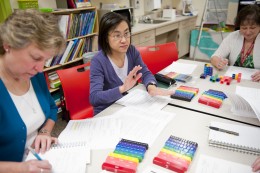They look for “the look.”
It’s the revealing expression on the face of a student that shows comprehension—understanding something that had once been a mystery.
Those doing the “looking” are teams of teachers who have redesigned their lessons and are giving them a test drive before classes of elementary and middle-school students.

Wright State professors Ann Farrell (left) and Sachika Tosa (middle) meet with teachers at Kemp PreK-8 School in Dayton on March 14. At right, is Kemp teacher Vicki Westerfield.
It is all part of a professional-development model for teachers being used in Dayton-area schools under the leadership of Wright State University.
The “Lesson Study” model is one of four professional-development programs for STEM teachers supported by Wright State in 2011-12.
With 164 teachers from 77 schools in 12 counties, the programs have directly affected the instruction of about 11,500 students annually. Priority is given to teachers from schools that enroll high percentages of underserved minorities and the economically disadvantaged.
Originating in Japan, the Lesson Study model used in one program has been credited for a shift from “teaching as telling” to “teaching for understanding” in math and science classes.
In addition to Lesson Study, Wright State also sponsors traditional professional-development programs in which teachers gather on campus for intensive summer workshops four days a week for three weeks.
PIES (Partners in Earth System Science) focuses on the teaching of earth science and chemistry and deals with issues such as water quality and environmental impact. The program often includes field trips to the ocean or Great Lakes.
Another program, STONE (Science Teaching for Ohio’s New Economy), is co-sponsored by the Ohio Aggregate and Industrial Mineral Association. The organization represents the aggregate industry, which, for example, mines sand and gravel for the production of concrete.
“The participants learn about the extraction of things that are used in commerce and techniques for estimating how much you might be able to take out, whether it’s economically feasible,” said Edgar Rutter, director of Wright State’s Center for Mathematics and Science Education.
The fourth program is a multidisciplinary effort that offers summer workshops for STEM teachers of grades 5-11 in three areas: life science, earth science and physical science.
Then, there is the Lesson Study program. Supporters say Lesson Study is flexible, inquiry driven, creates curiosity and keeps teachers in control while making students the focus. It is taking root across the United States, being used in classrooms from California to Chicago to Florida.
“To really improve education, we need a more systemic approach,” said Rutter. “Lesson Study often involves all the teachers of a particular subject matter within a school and has more potential to have schoolwide impact or even impact districtwide.”
For example, a group of teachers at a particular school might want to improve the teaching of fractions.
They first meet as a team and discuss weaknesses in the existing lesson. A new, redesigned lesson is then presented in the classroom under the observation of the team, which carefully scrutinizes student reaction. The team later meets to discuss what worked, what didn’t, and revises the lesson. There is then a second class presentation and second debriefing before the lesson revision is finalized.
Rutter said it’s all about the skill and methodology the teachers learn as they solve problems together.
“They, themselves, have the power to improve their schools and the outcomes for their students,” he said.
There are about 60 elementary and middle-school teachers in the Lesson Study program, most of them from Dayton Public Schools.
Wright State professor Ann Farrell and assistant professor Sachiko Tosa meet with small groups of the teachers at their schools in three-hour sessions. Between August and December 2011, the two spent 170 hours in the sessions.
Farrell said the teachers bring their problems to the table.
“We help them look at their textbook, at other resources, at their student work and try to find the answer,” she said. “They build off of each other’s expertise. We want them to be researchers in their own classrooms and do it collaboratively. That’s one of the lasting effects we think there will be.”
Lisa Minor, Dayton Public Schools’ executive director of school improvement for pre-K to 8, experienced the Lesson Study program for several years when she was principal at Kemp PreK-8 School.
“The redesigned lessons were more meaningful and relevant to the students,” said Minor. “And veteran teachers were revived and refreshed by the opportunities in the program.”
Math lessons include such things as ratios, bar graphs, classifying quadrilaterals and two-digit subtraction with regrouping. Other lessons focus on the teaching of history and social studies.
Lesson Study has also affected teaching styles. One teacher learned to not always give students the answers, but let them work through problems–even if they fail to solve them.
“She said, ‘I never realized how important student struggles are and that it’s OK for students to have some struggles with material,’” Farrell said.
Tosa said there have been improvements in student test scores at Kemp PreK-8, where all of the teachers participate in the Lesson Study program.
“There is some good evidence of teacher growth and student growth,” Tosa said.

 Wright State business professor, alumnus honored by regional technology organizations
Wright State business professor, alumnus honored by regional technology organizations  Wright State University Foundation awards 11 Students First Fund projects
Wright State University Foundation awards 11 Students First Fund projects  Gov. DeWine reappoints Board Treasurer Beth Ferris and names student Ella Vaught to Wright State Board of Trustees
Gov. DeWine reappoints Board Treasurer Beth Ferris and names student Ella Vaught to Wright State Board of Trustees  Joe Gruenberg’s 40-Year support for Wright State celebrated with Honorary Alumnus Award
Joe Gruenberg’s 40-Year support for Wright State celebrated with Honorary Alumnus Award  Wright State’s elementary education program earns A+ rating for math teacher training
Wright State’s elementary education program earns A+ rating for math teacher training 